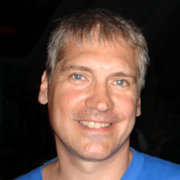
Abstract
In the last decade, the constant reduction in size and the growing number of material interfaces in electronic or optoelectronic devices (such as MQW-LEDs, organic or inorganic solar cells, ...) has boosted the impact of the intrinsic disorder present at smaller scales of materials. This disorder can originate from compositional inhomogeneities, from interface roughness or from lattice defects. Any realistic modeling should therefore account for these imperfections relative to the perfect homogeneous material as they can drastically impact the carrier transport or the coupling between carriers and light at the submicron level. Yet, to this day, very few or almost no simulation tool faithfully accounts for the effects of this disorder in the design of structures and devices.
We will present a paradigmatic case of such disorder-induced alteration, called "wave localization", and show how the issue of modeling disorder in quantum devices can be addressed in a efficient and systematic way.
In a disordered or random solid, electronic states can display a fascinating property i.e., the strong localization of their wavefunctions. Unlike the Bloch waves which are delocalized in the entire system, these wavefunctions are concentrated in a very limited region despite the absence of any apparent confining potential. Discovered in 1958 by Anderson (1977 Nobel Prize for this discovery), the mechanism of the disorder-induced localization still remains to this day mysterious for a large part. In particular, until recently it seemed very difficult or even impossible to predict the location of the localized states in a specific sample. Modeling carrier transport in a heterogeneous medium therefore usually requires recomputing all relevant eigenfunctions and eigenvalues of the corresponding Hamiltonian, a very tedious and time-consuming task, impossible to carry out in a full sized device.
In this seminar, we will present a totally new geometrical approach to localization. This theory is not restricted to quantum states, and can be applied in fact universally to all physical waves. It exhibits in any system a partition of disjoint regions which host the localized states, these regions acting as weakly coupled oscillators. The theory not only predicts localization of states at lower energies, but also the transition towards delocalized states at higher energy. Most of all, it allows for the first time to directly derive, by solving only one simple Dirichlet mathematical problem, yielding a function called "landscape" that determines the boundaries of the regions where one can expect the presence of localized states, and the energies of the transition to delocalised states .
We will show how computing this "landscape of localization" provides all the relevant information about localization, density of states, or average spatial distribution. Finally, we will propose a scheme to implement this new approach towards understanding and controlling the materials properties of heterogeneous or disordered systems or devices.
Biography
Marcel FILOCHE (P.I.) is Directeur de recherche CNRS, deputy director of the laboratory "Physique de la Matière Condensée" at Ecole polytechnique, and Professor at the École des Mines de Paris. He graduated from Ecole Polytechnique and got a PhD from the Université d'Orsay in semiconductor physics. His main research topic deals with the properties of systems of complex geometry. He is author or co-author of about 80 publications in peer reviewed journals.